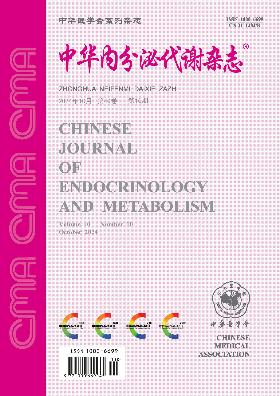Association between atherogenic index of plasma and renal function impairment in patients with gout
Q4 Medicine
引用次数: 0
Abstract
Objective To study the relationship between atherogenic index of plasma (AIP)and renal impairment in male patients with gout. Methods A retrospective analysis of 821 male subjects was conducted to measure the relevant biochemical indicators and to calculate the AIP, endogenous creatinine-clearance rate (Ccr), and estimated glomerular filtration rate (eGFR). EpiData 3.1 software was used for data entry, SPSS21.0 was used for statistical analysis, and GraphPad Prism 6.0 software was used for charts. Results Compared with control group, AIP, serum uric acid, triglyceride in gout group were significantly higher (all P 0.05), while Ccr and serum uric acid levels gradually increased (P<0.05). Logistic regression analysis after adjusting for various confounding factors showed that AIP, triglyceride, and serum uric acid were risk factors for renal function damage in patients with gout (P<0.05), the relevant risk were 7.030, 1.291, 1.004 respectively. After adjusting confounding factors, the associations between triglyceride, serum uric acid and renal function injury risk changed little, while AIP showed more evident, the OR value increased from 2.629 to 6.265 and 7.030. Conclusions (1)AIP is closely related to the renal function damage of patients with gout. After adjusting various confounding factors, AIP can better reflect the renal function damage than other indicators, which is of great significance to predict the renal function damage of patients with gout. (2)That patients with gout with high uric acid level may suffer from renal atherosclerosis and have a higher risk of renal impairment. (3)Dynamic observation of AIP in gout patients is helpful for early identification of the risk of renal failure in such patients. Key words: Gout; Renal damage; Atherogenic index of plasma; Confounding factors痛风患者血浆动脉粥样硬化指数与肾功能损害的关系
目的探讨男性痛风患者血浆动脉粥样硬化指数(AIP)与肾功能损害的关系。方法对821名男性受试者进行回顾性分析,测量相关生化指标,计算AIP、内源性肌酐清除率(Ccr)和估计肾小球滤过率(eGFR)。EpiData 3.1软件用于数据输入,SPSS21.0用于统计分析,GraphPad Prism 6.0软件用于图表。结果与对照组相比,痛风组的AIP、血清尿酸、甘油三酯显著升高(均P<0.05),Ccr和血清尿酸水平逐渐升高(P<0.05,相关风险分别为7.030、1.291和1.004。在调整混杂因素后,甘油三酯、血清尿酸与肾功能损伤风险之间的相关性变化不大,而AIP表现得更明显,OR值从2.629增加到6.265和7.030。结论(1)AIP与痛风患者肾功能损害密切相关。在调整了各种混杂因素后,AIP比其他指标更能反映肾功能损害,对预测痛风患者的肾功能损害具有重要意义。(2) 高尿酸水平的痛风患者可能患有肾动脉粥样硬化,肾功能损害的风险更高。(3) 对痛风患者AIP的动态观察有助于早期识别此类患者肾功能衰竭的风险。关键词:痛风;肾损伤;血浆动脉粥样硬化指数;混淆因素
本文章由计算机程序翻译,如有差异,请以英文原文为准。
求助全文
约1分钟内获得全文
求助全文
来源期刊

中华内分泌代谢杂志
Medicine-Endocrinology, Diabetes and Metabolism
CiteScore
0.60
自引率
0.00%
发文量
7243
期刊介绍:
The Chinese Journal of Endocrinology and Metabolism was founded in July 1985. It is a senior academic journal in the field of endocrinology and metabolism sponsored by the Chinese Medical Association. The journal aims to be the "Chinese broadcaster of new knowledge on endocrinology and metabolism worldwide". It reports leading scientific research results and clinical diagnosis and treatment experience in endocrinology and metabolism and related fields, as well as basic theoretical research that has a guiding role in endocrinology and metabolism clinics and is closely integrated with clinics. The journal is a core journal of Chinese science and technology (a statistical source journal of Chinese science and technology papers), and is included in Chinese and foreign statistical source journal databases such as the Chinese Science and Technology Papers and Citation Database, Chemical Abstracts, and Scopus.
 求助内容:
求助内容: 应助结果提醒方式:
应助结果提醒方式:


